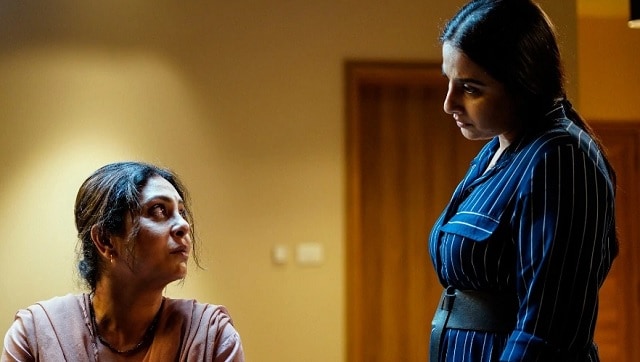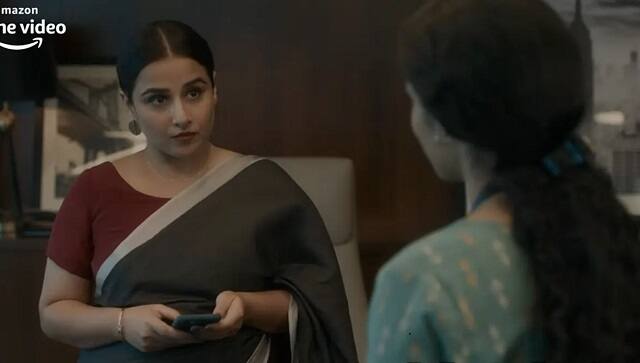Writer-director Suresh Triveni had two cornerstone images, two rhetorical adages that he kept in mind while making Jalsa — if your conscience comes under your wheels, will you leave it bleeding? If your conscience is at the edge of a pier, will you allow it to drown? Both images — that of wheels, that of a pier — bookend Jalsa. The film, starring Vidya Balan as Maya, the star journalist with a conscience that gets tested when she runs over the daughter of her house help Rukhsana (Shefali Shah), is immersive and lean, refusing to hammer its story, its message, allowing its subterranean subtexts to remain just that. Nothing bubbles to the surface. It is why the film is just as frustrating as it is rewarding. In an interview with Triveni, edited for length and clarity, the director breaks down the choices he made, constructing the film, decision by decision, a film which he calls, “a jalsa of irony, of coincidences, even.” *Spoilers ahead* You described Jalsa as a “hub and spoke” movie. But the central hub here is an act of radical coincidence — in this big teeming city, Maya runs over the daughter of her househelp. Were you worried this might be too much to be palatable? I knew some reviews would call it convenient. But for me, that was the basis of the film. When you are writing a script, you confront a lot of fears. Here, unlike Tumhari Sulu, I confronted the fear of coincidence. My film is not about investigation or journalism. If it was, at the end, I would have planted some articles saying “Maya Menon Confesses” etc. I did nothing of that sort. Coincidence was a conscious choice. We could have made the plot convoluted — newer characters, more events — to be more logical. But my fear was that I would move away from my central character and their emotions. What can you tell me about the men, or really, the lack of men in this movie? They all seem peripheral or meek or just girding the female characters. Was that conscious too? Someone told me long back, “Aap badi janani type ki picture banate hain” (laughs), It was not conscious. The conscious part, the greed, was to get Shefali and Vidya together. There was a point where I wondered if I should make the reporter Rohini Goerge (Vidhatri Bandi) a man instead. But the first name that came to me when thinking of the character was Rohini George. I disagree that the men are just there. Manav (Kaul), a dear friend, had told me, even if you want him for a passing shot, he’ll be there. In this film, he plays Anand, her divorced husband, but you won’t find a single dialogue like, “Jab mein aur Anand alag ho gaye the…” They are separated, they have a history, and he is still her pillar. They still have a relationship. She still goes to meet him when she feels cornered, and he still understands, asking “Sab theek?” Iqbal’s character, I agree, I was manipulative with, because I wanted to stir the idea that maybe he is behind all of this. I haven’t shown much of what he thinks. I also wanted to show the politics of men and women working together. There is also chemistry there. When, towards the end, he feels he has bailed her out, there is a confidence in his walk. Compare his first and last walk in the movie, when he peeks into her cabin. The women being there is purely because of greed. With Vidya and Shefali, I then asked, can I get Rohini Hattangadi as Vidya’s mother? That’s how I function. [caption id=“attachment_10476141” align=“alignnone” width=“640”]  Shefali Shah and Vidya Balan in Jalsa[/caption] That answers my next question: if the Maya-Rohini-Ruksana was a Hindu-Christian-Muslim trinity? But I guess it was incidental. I never looked at it like that. The more you underline the more you emphasize. In a film like this, with a patient lying in a bad condition, characters going through a horrible time, there is not a single shot of them going to a church, temple, or mosque. Nothing. That was conscious, right? It was. I hate underlining ideas. By doing this, perhaps did you take away any of these characters’ relationships with god by making it so spiritually neutral? I wanted it to be neutral, to show these are humans dealing with humans. I did not want a third entity. You must give me closure on Rohini George’s relationship with Amar Malhotra. Was Maya being paranoid or prescient when she insinuated something between the two? Why did Rohini go to Amar first? With Maya, I wanted to show someone with absolute control. There were a lot of arguments about that first scene where she just sits there. Normally, you would have a robust discussion for such an argumentative journalist. But I wanted to show her as someone with absolute control. She doesn’t even flinch. Then, for this character to spiral out and lose control of everything in life… See, there are five shades. One is shock. One is fear. One is denial. One is, certainly, manipulation. Finally, redemption. In that scene, she doesn’t trust anyone. She did not like that something was happening behind her back, and so she is doubtful. She is losing control of the situation. Hence, the trigger. It is more her problem than his problem. Did that answer your question? [caption id=“attachment_10446271” align=“alignnone” width=“640”]  Vidya Balan in Jalsa[/caption] It did. But I guess both the beauty and the agony of watching this movie is that you do not lay things out as neatly as we are used to seeing in movies. Me and my editor Shivkumar Panicker have a lovely relationship. We tried to experiment with the show-and-tell stuff. Cinema is such an audio-visual medium, we don’t have to show and also say at the same time. That was the attempt. Your casting director Anmol Ahuja told me that you had a relative with cerebral palsy. Can you tell me how and when you brought that angle into the writing of Ayush’s (Surya Kashibhatla) character? Was he always supposed to have cerebral palsy? I am a very strong believer in the first image that comes to me. I go by my gut. When Ayush’s character came up, the first thing I thought of was my nephew Siddharth, now a 23-year-old guy, who has cerebral palsy. It did not come from a place of being a flagbearer of inclusion. I have not mentioned the condition in my film. No dialogues like, “Arey yaar mere bete ko cerebral palsy hai.” That is not the space I wanted to go into. At one point, I even wondered if I was doing this because I want to be exploitative. I kept wondering if it was some other kid, would I have still followed the same plot? The answer is yes. See, every character has to bring in a novelty. I was lucky to find Surya Kashibhatla, a child with this condition. This brings me to two scenes I am not entirely sure of. One is the decision to mute Maya’s dialogues when she goes berserk on her son, calling him weird. Why did you do that? Did you already have dialogues in place and made this decision in the edit? It is almost as if you do not want her to be entirely unlikeable. I will be honest. It was one of the toughest scenes I have shot. I know it was one of Vidya’s most difficult scenes. We had dialogues written. But at the edit level, we decided we would use violins. This was the lowest that Maya’s character could go. If you notice, we used this theme music for the first time when Maya walks into the hospital ward, where there is a lot of chaos, and this music takes over in that single shot. We wanted the song to feel like a pattern. So when the scene was unfolding at the edit level, we wondered if we could just put music there and see what it looked like. Look at her face, the way she is going for it. Now, we get all the time to look at the face, seeing the character more clearly, how her hands are moving. There was a parent who called me saying they were so happy I muted it. It has nothing to do with making anyone good or bad. It was just about not showing violence. Another scene I did this was when the two boys confess in front of Ruksana on that rainy night. After a point, it was just music. That ending, I am still not sure of. There is Maya’s confession but you do not show it getting released into the world because you wanted to stay with the characters. So you have happiness but also impending doom. But is it too ambiguous? We are used to the world of monologues. Even in Tumhari Sulu there is one. As writers and filmmakers, we debate about it, after saying the full story, again why are we summarising it? Here, I wanted a confessional. It was a redemption-revenge story, so by the time one character is redeeming, the other is beginning to seek revenge. The film is not about journalism or a police procedural investigation. My attempt was to look inwards. The last shot was supposed to have a dialogue. It was there in the script, where Ruksana says, “Darya chadh raha hai, ghar jaate hai” [There is a high tide, let us go home]. But we decided to scrap it because suddenly, it feels like poetry coming out unnaturally. We shouldn’t forget that Ruksana was about to drown that boy. Then Maya walks in and sits. What do they say to each other? I didn’t want to know.
I could have also easily put images of Maya’s confessional going viral. But that wasn’t the film for me. The film was about Maya confessing to herself.
Where does Rukhsana’s son come from, then, at the end of the film? He was not at the beach with Rukhsana and Ayush, right? I felt it was not necessary for me to explain that. Of course, you confront these realities while writing a script. I could have shown another visual of her running towards the pier, holding Ayush and bringing him back towards the shore. In one draft, while Rukhsana is contemplating at the beach, her son comes. This makes sense because in a previous scene, Ayush asks her son, “Tu mujhe darya cricket khelne bulayega?” (Will you invite me to play cricket on the beach?) So it becomes a closure for that. I could have done that, but did not feel it necessary. I don’t need to go by logic throughout. It is not even a leap of faith. The logic is anyway thrown out of the window when you see an empty beach in Mumbai. Jalsa is streaming on Amazon Prime Video India. Prathyush Parasuraman is a critic and journalist, who writes a weekly newsletter on culture, literature, and cinema at prathyush.substack.com. Read all the Latest News , Trending News , Cricket News , Bollywood News , India News and Entertainment News here. Follow us on Facebook, Twitter and Instagram.


)
)
)
)
)
)
)
)
)



